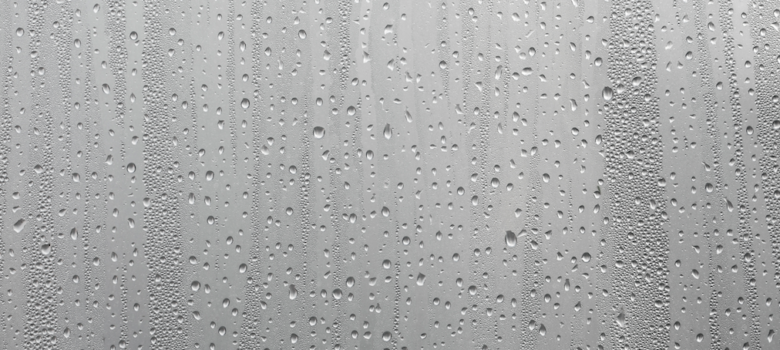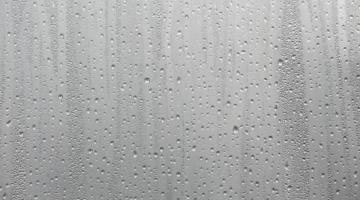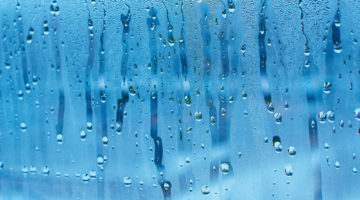
We have discussed this before, but new windows are normally a fantastic way to improve both the appearance and thermal comfort of your home. New double/triple glazing tends to retain far more heat within the home, minimising the time your heating needs to be on as well as keeping rooms at a more stable internal temperature. New windows also tend to help reduce condensation on the glass, because the internal pane of glass is that much warmer than single glazing, so the moisture in the air doesn’t condense on it, helping keep the windows mist-free!
Condensation forming between the panes of glass is common in slightly older double glazing – the reason for this is normally because the airtight seal on the double glazing unit has broken down, allowing air to enter the space between the two pains.
A problem we are beginning to hear quite a lot about though is condensation appearing on the outside of the window, and as you might expect people aren’t happy about it! Imagine forking out thousands of pounds for new windows only for condensation to form on the outside of windows, ruining the views out of your home.
Why does condensation form on the outside of new double glazing?
Unfortunately, condensation forming on the outside of new double glazing is a natural phenomenon and it arises because the window is working so well at preventing heat loss from your home.
Condensation is defined as the process by which gas turns into a liquid. If the temperature of an object falls below what is known as the dew point temperature, then water vapour from the air will condense on the object’s surface. The dew point varies according to the amount of water in the air (compare a shower room to a sitting room for example) and the temperature of the air. The warmer the air, the more water vapour it can hold – but it can only hold so much, so if this saturated air encounters a surface that is below the dew point temperature, then it will condense.
The reason water condenses on the outside surface of the glass is the temperature of the glass drops below the external dew point temperature. The new double or triple glazing units tend to have inner panes made up of low emissivity glass and this prevents the movement of heat across the glazing unit, so the outer pane never gets warm.
As mentioned at the beginning of this article, condensation forming on the outside of your new windows is actually an indication that your new windows are performing very well, although we appreciate it is not ideal!
What can I do about condensation forming on the outside of double glazing?
Whilst simple methods of removing condensation yourself do exist, they are not permanent effects. Most signs of condensation are caused by excess moisture in the air, which leads to the process of mould growth, water droplets, peeling wallpaper and musty smells. One of the best solutions to condensation is to heat your home. However, they would have to be on 24/7 racking up energy bills. So, is there a heating that can eradicate mould completely?
Convection heating is to blame. Leaving convection heating on won’t reduce condensation because it heats the air directly pushing warm air around the room. As Warm air tends to hold moisture when it meets a cold surface, condensation will take place on the windows.
Infrared heating is the best solution to eliminating condensation. Let’s think about how condensation evaporates when the sun rises. Infrared heating works in the same way just like the sun by converting electricity into radiant heat. As Infrared heating heats the objects in the rooms directly and not the air, there’s no need to worry about condensation forming. The radiant heat transmits waves that dry the walls and double glazing from the inside out, even when the heating is turned off. Therefore, water vapour will not occur. If the heating is required to turn back on, they can heat up pretty quickly. A Jigsaw Infrared heater can heat up in less than 5 minutes certainly making sure there is no chance of any moisture in the air. This means no dampness and no mould for good. Even in a bathroom where mould occurs the most frequently.











What about secondary glazing or plastic shrink wrap window insulation? Could these be installed externally?
Hi Marsus,
While secondary glazing like Ecoease does have a number of excellent benefits, I’m afraid that neither of these solutions is really designed for external use.
thank you for the information it was very helpful
Imagine my surprise this morning, when I drew back curtains and blinds on all my two week old (and expensive) double glazing had condensed water on the outside of every window. None of the other windows in nearby houses had this.
Your detailed explanation has gone a good way to relieving my “panic”. Thanks for that reminder of school physics that I had learnt, but not reflected upon for fifty years now.
Thanks for the article and the points for how the condensation is created and how to prevent it. Also the comment about mold and allergies, too many homeowners don’t consider that. While there are DIY tricks, we always suggest that homeowners have professionals evaluate the issues.
Personally, I would rather have a slightly cooler house and windows I can see out of in a morning! I do not believe that all my neighbours have poor quality windows – theirs do not have external condensation. I would love to be able to afford to have these awful expensive windows removed and replaced with ones I can enjoy my garden views from.
I,m with Tania why have windows you can’t see out of for 1/2 the morning
OK, so it’s July and we’ve just had new windows put in. We are in the middle of a heat wave with occasional thunderstorms. Very hot and humid outside. Getting condensation on the windows – suggests that for some reason the outside surface of the windows is colder than the ambient temperature. Only explanation I can think of is that the double glazing is falling a long way short of what we were promised and that the cold from the airconditioning is communicating through the double glazing to the outside surface. The next time someone bullshits me about R factors I shall keep my money in my pocket.
Why did you fit double glazing. It is intended to keep the heat in, but you have air conditioning to keep the house cool.
Excellent article. This phenomenon was driving me nuts in my new home. Now I know not to rant and rave about it, ha. Thank you.
Thank you for explaining about the condensation on our new replaced window!
E A
Thank you for the information about the condensation on my out side windows.
One solution that works for us. We have a large triple glazed window over looking the terrace. We have a store over the terrace to protect from sun. So when we know the night sky will be clear, we keep the store open. That “hides” the cold night dark sky and in the morning we have no condensation. Probably works too if you have external blinds you can close.
Thanks for your information.
Your article is very interesting and helped solve the mystery of why our new windows are condensating outside. However, your solutions for what can be done to prevent it appear to be aimed at internal prevention. Surely you’re not suggesting that heating the room inside will prevent condensation forming outside?
Will triple glazing reduce condensation – or is it a waste of money for this purpose?
My old windows never had fog l think l would rather have my old windows back .l think the explanation is bullshit. What,s the point of fog everyday you can’t see out side its so foggy and after the fog disappears the window is streaky and dirty garbage windows non-sense excuse .l would be pleased if these shit windows were removed immeddiately
I personally hate this excuse , my old windows thermal pane 60 years old zero fog. If customer was told you won’t be able to see out your windows for most of the morning would these people still buy these ugly windows or repair existing windows , lknow l would not have bought a window l can’t see out of.
Mine do this – the same guy fitted windows next door (both sides) and theirs don’t fog up on the outside. I thought there was some kind of sticky residue left on the pane from a peel off label that was causing it as always a couple of inches clear ‘border’ around the misted up part!! Agree with others comments, it is very frustrating to buy new windows then you can’t see out!! Glad I’ve seen the article was just about to send pictures to the fitter thinking they are faulty units
Reading one of the reply’s has helped answer a question witch puzzled me. I had two new windows fitted, one containing two panel and the other one having one panel. All three panels when mistered have a boarder of approximately 5omm clear glass around all sides. It has puzzled me as to why the edges of the mistered section are so perfect and the corners a sharp, equal radius, I am glad to see I’m not the only one experiencing this however the fact that there is a clear area around the outside of the panel, is there a reason why?